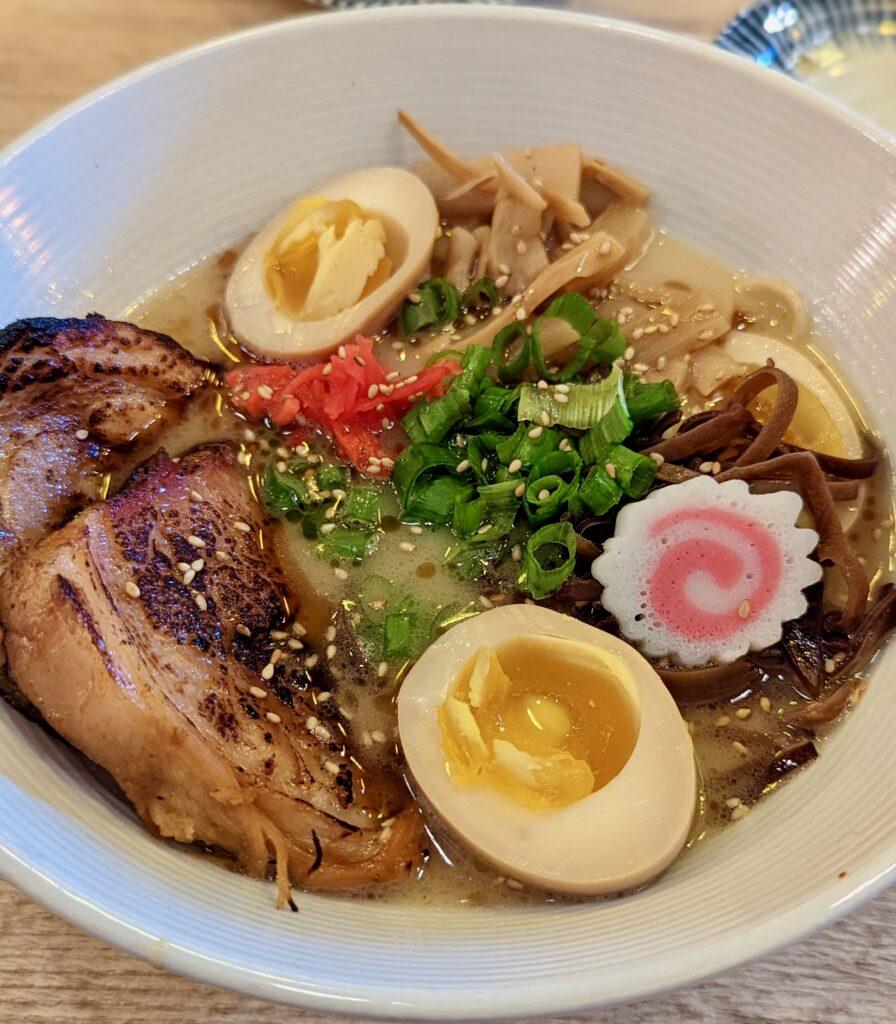A Taste of Ramen in the First State
Not many travelers expect to find ramen when visiting Delaware. “The First State ” offers year-round steamed crab dusted in old bay, as well as radiant beaches unencumbered by tourists. While we came for the sandy shores, the allure of discovering new ramen led us to the sleepy beach town of Rehoboth. It wasn’t known as a culinary mecca, so we kept our expectations low as we meandered into Miyagi Ramen Bar, a quaint restaurant tucked between a Charles Schwab and Moe’s Southwestern in a small, suburban strip mall.
We sat down at one of the tables and appreciated the thematically unified Japanese decor. A Totoro mural filled the back wall, while vertically aligned hiragana, katana, and kanji signs were disjointedly plastered across the rest. This was in contrast to their eclectic menu, which drew from a wide range of Eastern Asian and Southeast Asian inspirations, subtly hinting at their overextended reach in breadth. Thai, Korean and even gluten free options were available. I felt overwhelmed with the amount of choices, but understood the need to cater to American consumerism. In the end, I chose the most popular item on the menu, the black garlic tonkotsu.
At first glance, the bowl seemed full and robust. There were thick slabs of floating pork chashu with hints of cilantro and breaching the murky depths of the enriched broth. Yet, most of the broth was encumbered by the sheer volume of toppings buoyed atop. The ramen eggs underwhelmed, appearing overcooked. But, true to its word, the ramen smelled heavily of garlic.
I decided to dig in immediately, sipping the broth one spoonful at a time. In broth, I usually look for depth, carefully teasing out the salt, fat, acid, heat, sweetness and umami flavors. To start with, the broth was not thick, but tasted rich in pork flavor. It definitely hit on loud, monotonous notes of garlic. I also couldn’t tell what “blackened garlic” really meant for this dish beyond just regular garlic. It may be because the garlic overpowered the other seasonings but it wasn’t apparent what the other flavors were supposed to come through in this broth. In that sense, it was a bit one-dimensional.
The noodles surprised me. When I used my chopsticks to hold them, they felt thin, yet relatively firm. This is the preferred cooking style for tonkotsu and I imagine they were made in-house with a high level of quality.
Pork chashu is one of my favorite parts of ramen, and I usually save the best for last. It was, unfortunately, my biggest letdown. As soon as I lifted it, I realized this wasn’t the tender, juicy, and fall-off-the-utensil chashu that I’m usually spoiled with. Although it appeared marbled and marinated, it was actually tough and overcooked. I needed a knife just to be able to cut it into smaller pieces and its stiff texture pulled away any flavor that remained.
Overall, the dish was a rollercoaster of ups and downs. While the visual aesthetics and aromas were initially tempting, the lack of substance in the broth and chashu left too large a detriment to be made up by the noodles alone. In addition, the ajitsuke tamago seemed like an afterthought. I applaud the creativity of the dishes available but the execution missed the mark. The mastery of ramen takes years of practice and dedication to every aspect including the broth, the noodles, the chashu and the toppings. Adding layers of complexity is an additional challenge that Miyagi Ramen Bar struggled with during our visit. Our recommendation to visitors would be to stick to more mainstream options and temper expectations.
Bonus: We had the chance to additionally sample the bulgogi ramen and the tonkotsu buns. I will give this bowl points for the creativity in the Korean inspired ramen bowl. The meat was tender and the ramen itself was more flavorful than the tonkotsu bowl. The addition of ingredients like kimchi definitely melded well. Unfortunately the same cannot be said about the buns as the meat was tougher than expected and the bun itself lacked a flavorful sauce. Additionally the dough of the buns was too thin and fell apart like a soggy burger.
